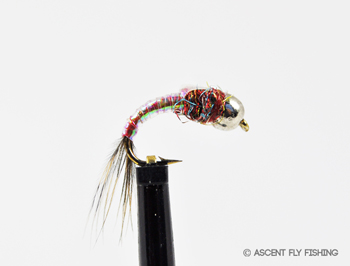How & Why to Use Weight When Fly Fishing
Posted by Peter Stitcher on 4th Nov 2015
Like every fly fisherman, I eagerly anticipate the season when warm nights and sunny days bring fish to the surface to feed on dry flies. Living in the Rocky Mountain West, this season is regrettably shorter than I would like, with Fall frosts creeping down the mountains in early September, and the oft unpunctual Spring failing to arrive and sweep out high elevation snows until mid-July. It is in these cold months, and in-between times when fish are not actively feeding at the surface, that we need to go deep and plumb the depths of the river with nymph rigs in order to hook up.
I began my fly fishing career, like many of you, with a single dry fly on the water, and the words "drag free drift" echoing in my ears. When drifting a dry fly down the river, we were taught to constantly mend and loop our fly line upstream so that it would not catch in the current and transfer an unnatural drag or pull onto our fly. The transition from dry fly fishing to nymph rigs cast beneath a strike indicator is a challenge for many fly fishermen. Whether it is the fear of losing flies among the rocks on the bottom of the river, or the ghosts of our tutors telling us to go with the flow and match our drift to the surface of the river, nymphing does not come easily to most.
The common sin of the fly fishermen when nymphing is not getting their flies deep enough. Trout spend the majority of their time (and do 75% of their feeding) close to the bottom of the river, taking refuge from the river's current behind and the boulders and logs the make up the bottom of the channel, and in the slow-water depths of pools. The challenge for the angler is to get their wet flies and nymphs into this zone of lower velocity on the bottom of the river, through the layers of faster water speeding along the surface. These pockets of slow water that hold fish might be quite small, requiring the angler to get their offering down quickly so as not to drift over the heads of the trout. With so many different weights on the market, let's take a minute to discuss the merits and uses of each.
In order to get your flies into the feeding zone on the bottom of the river, you need to have enough tippet or leader between your strike indicator and flies (typically 1.5X - 2X the depth of the water being fished), and you will need to add weight. Whether you are adding the weight to your line or incorporating it into your fly, it is important to understand the relative merits of each type of metal commonly available on the market.
TIN
Tin weights are a relatively recent addition to the fly angler's arsenal and have a density of 7.31 g/cm3. A non-toxic alternative to the traditional lead weights, Boss Tin is made in Colorado and can be pinched to your leader or tippet to help sink your flies. An innovative change brought to the water by Boss Tin weights is their "Stix" shaped weights whose long, slim profiles tend to snag less than the traditional round split shot. For a long drift or shallow water, tin is a great option.
BRASS
Brass has a density of 8.70 g/cm3 and is the second lightest weight metal commonly used as a weight for flies. Found in the form or beadheads and coneheads and tied into flies, brass adds a little flash to fly the while while aiding it in the slow sink of the fly as it progresses down stream. By itself, a brass beadhead adds only minimal weight and should be accompanied by extra weight attached to the line, or a second beadhead pattern dropped beneath the first.
LEAD
Lead is among the cheapest and most common metals used in fly fishing. Having a density of 11.34 g/cm3, this malleable metal is wound in wire form around the core of many fly patterns, and can be pinched to your leader as a splitshot. Noticeably heavier than brass or tin, a little lead goes a long ways in sinking your flies.

TUNGSTEN
When short drift distances or extreme water depths make it difficult to get your flies to the fish, it is time to break out the tungsten! Tungsten has the greatest density and is approximately 2x heavier than brass and 1.5x heavier than lead at 19.4 g/cm3. Commonly found in the form of a bead or conehead that can be tied into your fly, or a putty that can be pinched onto your line, no metal on the market will get you down deep as quickly as tungsten.
Whatever the combination of tin, brass, lead, and tungsten that you choose to use the important point is that you want to be bouncing your flies off the bottom of the stream. When the bite is slow next time you're on the water, add weight, go deep, and anticipate the strike!





